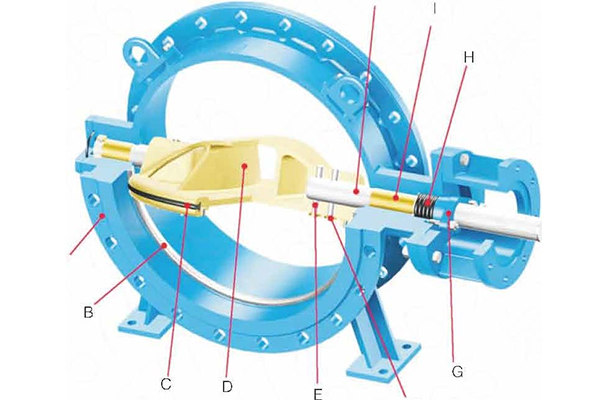 English
English Español
Español  Português
Português  русский
русский  Français
Français  日本語
日本語  Deutsch
Deutsch  tiếng Việt
tiếng Việt  Italiano
Italiano  Nederlands
Nederlands  ภาษาไทย
ภาษาไทย  Polski
Polski  한국어
한국어  Svenska
Svenska  magyar
magyar  Malay
Malay  বাংলা ভাষার
বাংলা ভাষার  Dansk
Dansk  Suomi
Suomi  हिन्दी
हिन्दी  Pilipino
Pilipino  Türkçe
Türkçe  Gaeilge
Gaeilge  العربية
العربية  Indonesia
Indonesia  Norsk
Norsk  تمل
تمل  český
český  ελληνικά
ελληνικά  український
український  Javanese
Javanese  فارسی
فارسی  தமிழ்
தமிழ்  తెలుగు
తెలుగు  नेपाली
नेपाली  Burmese
Burmese  български
български  ລາວ
ລາວ  Latine
Latine  Қазақша
Қазақша  Euskal
Euskal  Azərbaycan
Azərbaycan  Slovenský jazyk
Slovenský jazyk  Македонски
Македонски  Lietuvos
Lietuvos  Eesti Keel
Eesti Keel  Română
Română  Slovenski
Slovenski  मराठी
मराठी  Srpski језик
Srpski језик
How to Select Parts for Rubber Seated Butterfly Valve
2021-08-15
Each part serves a significant purpose in the unique design of a rubber seated valve. The butterfly valve dimensions must be precisely suited for various industry standards and functions. Sound operation and reliable sealing are needed for applications in the following scenarios:
·Pharmaceutical industry
·Chemical processes
·Food industry
·Water and wastewater
·Fire protection systems
·Gas supply likes
·Low-pressure steam
The central design of the standard zero-offset butterfly valve has all the pieces in the center. The valve body has no offset, nor is there a stem packing adjustment. The disc rotates a full 360º around the central axis with a secure seal made between the disc edge and the rubber seat at the stem.
The rubber seat that covers the body prohibits the valve from coming into contact with the materials that flow through the pipe. The following parts work together to ensure that the media remains untouched.
·Body
·Neck
·Disc
·Seat
·Stem
·Dust Seal (Packing)
·Bushings or Bearings
·Operator
To better understand how each part is involved, we’ll go over the different components of the rubber seated valve anatomy:
Butterfly Valve Body
You’ll find the valve body between the pipe flanges as it holds the valve components in place. The valve body material is metal and made from either carbon steel, stainless steel, titanium alloy, nickel alloy, or aluminum bronze. All but carbon steel are appropriate for corrosive environments.
The body for a butterfly valve is typically either a lug type, a wafer type, or double flange.
·Lug
·Protruding lugs that have bolt holes to match with those in the pipe flange.
·Allows dead-end service or downstream piping removal.
·Threaded bolts around the entire area make it a safer option.
·Offers end-of-line service.
·Weaker threads mean lower torque ratings
·Wafer
·Sandwiched between the pipe flanges with flange bolts surrounding the body.
·Features two or more centering holes to help with installation.
·Does not transfer the weight of the piping system through the valve body directly.
·Lighter and cheaper.
·Cannot be used as a pipe end.
·Double flange
·Connect with the pipe flanges (flange face on both sides of the valve).
·Pharmaceutical industry
·Chemical processes
·Food industry
·Water and wastewater
·Fire protection systems
·Gas supply likes
·Low-pressure steam
The central design of the standard zero-offset butterfly valve has all the pieces in the center. The valve body has no offset, nor is there a stem packing adjustment. The disc rotates a full 360º around the central axis with a secure seal made between the disc edge and the rubber seat at the stem.
The rubber seat that covers the body prohibits the valve from coming into contact with the materials that flow through the pipe. The following parts work together to ensure that the media remains untouched.
·Body
·Neck
·Disc
·Seat
·Stem
·Dust Seal (Packing)
·Bushings or Bearings
·Operator
To better understand how each part is involved, we’ll go over the different components of the rubber seated valve anatomy:
Butterfly Valve Body
You’ll find the valve body between the pipe flanges as it holds the valve components in place. The valve body material is metal and made from either carbon steel, stainless steel, titanium alloy, nickel alloy, or aluminum bronze. All but carbon steel are appropriate for corrosive environments.
The body for a butterfly valve is typically either a lug type, a wafer type, or double flange.
·Lug
·Protruding lugs that have bolt holes to match with those in the pipe flange.
·Allows dead-end service or downstream piping removal.
·Threaded bolts around the entire area make it a safer option.
·Offers end-of-line service.
·Weaker threads mean lower torque ratings
·Wafer
·Sandwiched between the pipe flanges with flange bolts surrounding the body.
·Features two or more centering holes to help with installation.
·Does not transfer the weight of the piping system through the valve body directly.
·Lighter and cheaper.
·Cannot be used as a pipe end.
·Double flange
·Connect with the pipe flanges (flange face on both sides of the valve).
·Popular for large size valves.

We use cookies to offer you a better browsing experience, analyze site traffic and personalize content. By using this site, you agree to our use of cookies.
Privacy Policy




